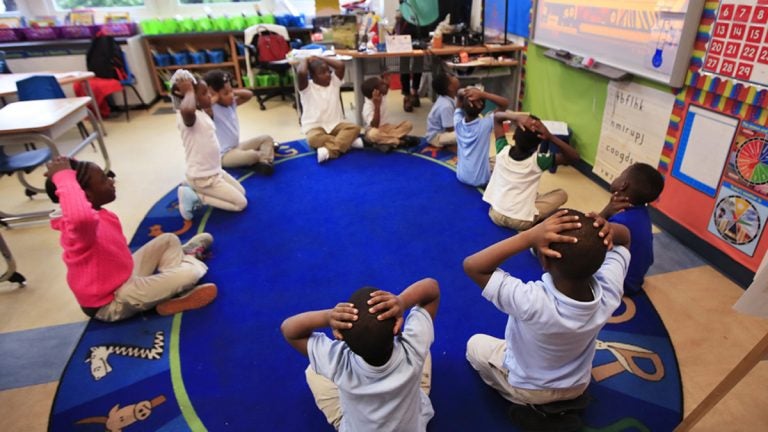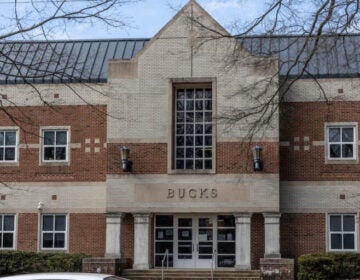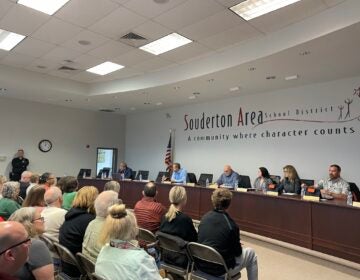Report on ‘chronic teacher absenteeism’ in Pa. highlights union’s role, spurs further questions
Listen
An elementary school teacher instructs students to put their hands over their heads. (AP File Photo/Manuel Balce Ceneta)
A new report finds that teachers in traditional public schools are almost three times as likely to be chronically absent as teachers in charter schools. But some say the report raises more questions than answers.
In any contentious debate, getting two sides to agree to the same set of facts can be an elusive, frustrating endeavor.
And, sometimes, the more you push on facts, the more squishy they become.
Take, for instance, a report out this week on chronic teacher absenteeism by the Thomas B. Fordham Institute.
It used federal Office of Civil Rights data and found these indisputable facts: Nationally, 28.3 percent of teachers in traditional public schools are chronically absent, compared with 10.3 percent in the charter sector.
A similar rate difference holds in Pennsylvania, where 32.1 percent of traditional public school teachers are considered chronically absent versus 8.2 percent in charters.
According to the U.S. Office of Civil Rights, a teacher who is out for more than 10 days in a school year is considered chronically absent.
The data for both sectors is based on federal OCR data from 2013-14 that was released in 2016. Absences are counted as instructional days missed for sick leave and personal time.
“There’s this big difference in teacher attendance between these two types of public schools, and it seems like there’s some pretty clear links between the policies that states and districts adopt and the rates of chronic teacher absenteeism,” said David Griffith, a senior researcher at Fordham, a D.C.-based education-reform think tank.
Another fact: Griffith notes that the gap in chronic teacher absenteeism is widest in states, such as Pennsylvania, where districts must go through collective bargaining with teachers, but charter schools are allowed to avoid that provision.
Relying on survey data, Fordham also examined the difference between unionized charters and nonunionized charters, and found that a gap appears there as well.
“In places where teachers do have really high job security, it’s certainly possible that they feel more comfortable taking more sick days,” he said.
Based on this data, Griffith said he’d like to see states and districts take a more restrictive approach to capping the number of sick and/or personal days teachers are allowed. Many states, including Pennsylvania, set that number at 10. Texas sets it at five.
Some states leave the decision to districts. Most also set the number at 10, but some offer teachers as few as seven sick and/or personal days, others as many as 25. In January, the Pennsylvania Senate Education Committee voted to strip the state mandate for teacher sick time, but the measure hasn’t advanced further.
The report also notes that many states, including Pennsylvania, are adding “chronic student absenteeism” to their list of school quality indicators as part of their plans to comply with the new federal education law. Fordham suggests tracking chronic teacher absenteeism as well.
Fordham’s report was funded by the Walton Family Foundation, which is in the midst of a $1 billion campaign to help expand charter schools nationwide.
“People can draw their own conclusions about that,” said Griffith. “Ultimately, the numbers speak for themselves.”
Missing context?
But are these facts everything they seem?
“Telling a story with data is not the same as reaching a conclusion based on evidence. And so I think more evidence is needed to really get to the bottom of it,” said Philip Sirinides, an assistant professor of research at the University of Pennsylvania’s Graduate School of Education.
Sirinides went through the same federal ORC dataset as Fordham, and found some important nuances that didn’t make the report.
For instance, OCR data tracks teachers who are in the first two years of their careers, and the numbers show that these teachers are much less likely to be chronically absent — no matter which sector employs them.
Sirinides points out that Pennsylvania data shows that 25 percent of teachers in charters are in their first or second year. In traditional public schools, just 8 percent fit that bill.
So, without this and other context considered, Sirinides doesn’t put much stock into the report, calling it “elevator analysis.”
“For the conclusions in this report to really be persuasive, those differences should be incorporated into the research method, so that the comparison between rates in charter and district schools is apples to apples,” he said.
Advocates for traditional public schools had similar critiques.
In Pennsylvania, the median average years of service for teachers in district schools is more than double that of teachers in the charter sector — data which further suggests that traditional public schools employ an older workforce.
“When people are in their 50s or 60s or 70s, they are more likely to have health issues than normally healthy people in their 20s,” said Jerry Jordan, president of the Philadelphia Federation of Teachers. Philadelphia has the state’s highest concentration of charter school teachers.
In a follow-up interview, Griffith defended his findings, but acknowledged that the study could have included more context.
“We could have controlled for a lot of things, right? But until somebody shows me data that shows that the results change substantially when you do that, I guess my reaction is … the study speaks for itself,” he said.
The Fordham report also didn’t delve into the issue of teacher turnover, which is higher in the charter sector.
But, that’s an example of a fact that can be overblown by traditional public school advocates — as, in recent years, the turnover rates for the different sectors have significantly narrowed.
Overall, putting the debate between charter and district schools aside, the rate of chronic teacher absenteeism has improved. In 2012, the Office of Civil Rights found that 36 percent of U.S. teachers were chronically absent. The most recent data puts the overall rate at 27 percent.
For Donna Cooper, the executive director of the Philadelphia-based Public Citizens for Children and Youth, these numbers still highlight a real problem — one, though, that she says rises above a debate about school governance.
“The challenge for me is: How do we build a system that recognizes that it’s tough to educate children, especially children in extraordinarily stressed families,” she said, “and create schools that have enough adults that can fill in when an adult is burned out or an adult is unable to be there because of a birth, a death, a family emergency or an illness.”
She wants schools to have a dedicated substitute teacher in the building every day who knows the children and is effective teaching a wide array of curriculum.
But, the fact is, that plan would require a significant new financial investment in a state that’s currently struggling to figure out how to pay its existing bills.
WHYY is your source for fact-based, in-depth journalism and information. As a nonprofit organization, we rely on financial support from readers like you. Please give today.






